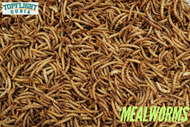Mealworms - Your Ideal Pet Food
Posted by TopFlight Dubia on Apr 4th 2024
Mealworms are larvae of mealworm beetles (Tenebrio molitor) and are ideal pet foods, especially for chickens.
Yellow mealworms are the immature stage of the mealworm beetle, a species of darkling beetle. They feed on grains, especially those that are commonly stored. In their natural habitat, they are natural decomposers that help them break down organic matter.
TopFlight Dubia offers this guide to help you learn everything about mealworms so your reptiles, amphibians, or pet chickens will never go hungry.
Nutritional Content Of Mealworms
Here is the breakdown of the nutritional value per 100g dry weight:
|
Micronutrients
- Vitamins:
B Vitamins (B2, B5, B7)
Vitamin A
- Minerals:
Iron: 3-6%
Zinc: 2-5%
Magnesium: 1-3%
Calcium: 0.5-1.5%
NOTE: Mealworms are more economical and healthy than conventional meal protein sources.
The Life Cycle Of A Mealworm
To fully appreciate the nutritional value and potential of mealworms, it's helpful to understand their life cycle:
- Egg: It is minuscule white, which makes these eggs nearly inconspicuous to the human eye or resemble small grains.
- Larva: This is the phase most would call a mealworm. For most of their lives, they are in this form; they are large, feed, and molt several times.
- Pupa: When it gets large enough, it forms a tough exterior covering over it and becomes a cocoon or pupa.
- Adult Beetle: A pupa forms later than the larvae, and it finally hatches into a small, blackish, deflated, six-legged bug known as the darkling beetle or sentimental beetle.
This is the mealworm’s adult form. After adulthood, beetles are more involved in mating and laying eggs to continue the cycle.
Possible Problems in Mealworm Rearing
While mealworm care is relatively straightforward, some common issues can arise:
- Mold: Mold is particularly rancid in moist areas, so adequate aeration, along with proper substrate management, is very important.
- Pests: Other insects like mites also harm the mealworm colonies since these insects contaminate them and cause diseases.
- Cannibalism: Lack of space and or food give rise to cannibalism; it is common among adult beetles.
The majority of the more than five thousand species of beetles are not hazardous to humans or pose any threat to human existence despite their being insects.
- Escape: Mealworms can move around a lot and easily crawl out of containers that need to be.
Care Of Mealworms
Breeding mealworms is a fun endeavor, and it is simple. Here are some tips to ensure a thriving colony:
Housing
- Substrate: Ideally, offer bran, oatmeal, or a mixture.
- Ventilation: Ventilation should be well-finished to avoid cases like moldy air and growth on walls.
- Temperature and Humidity: Keep the water at 70-80 °F (21-27 °C) and moderate humidity.
Feeding
- Diet: Provide fresh fruits and vegetables, including carrots, apples, and lettuce.
Cleaning and Maintenance
- Regular Cleaning: Discard products such as vegetables and other edible substances that are left over to avoid cases where they attract insects, such as flies, that spread the source of diseases.
- Separation: The adults should be placed in a different container to avoid cannibalizing the larvae and overcrowding.
Harvesting Mealworms
- Sifting: Sieve the larvae from the substrate to remove the substrate from the worms.
- Storing: Storing harvested mealworms should be done in cool and dark areas.
Get High-Quality Feeder Mealworms From TopFlight Dubia
These larvae are productivity-beneficial foods for pets like chickens. Understanding the life cycle of these larvae and how they should be cared for to strengthen their colony ensures a continuous healthy diet for pets.
TopFlight Dubia offers premium Dubia roaches that are equivalent to mealworms in terms of nutrition.
With years of experience and excellent customer support, we’re happy to help and guide you through every step.
Go through our collection and get the most nutritious food for your pet.

